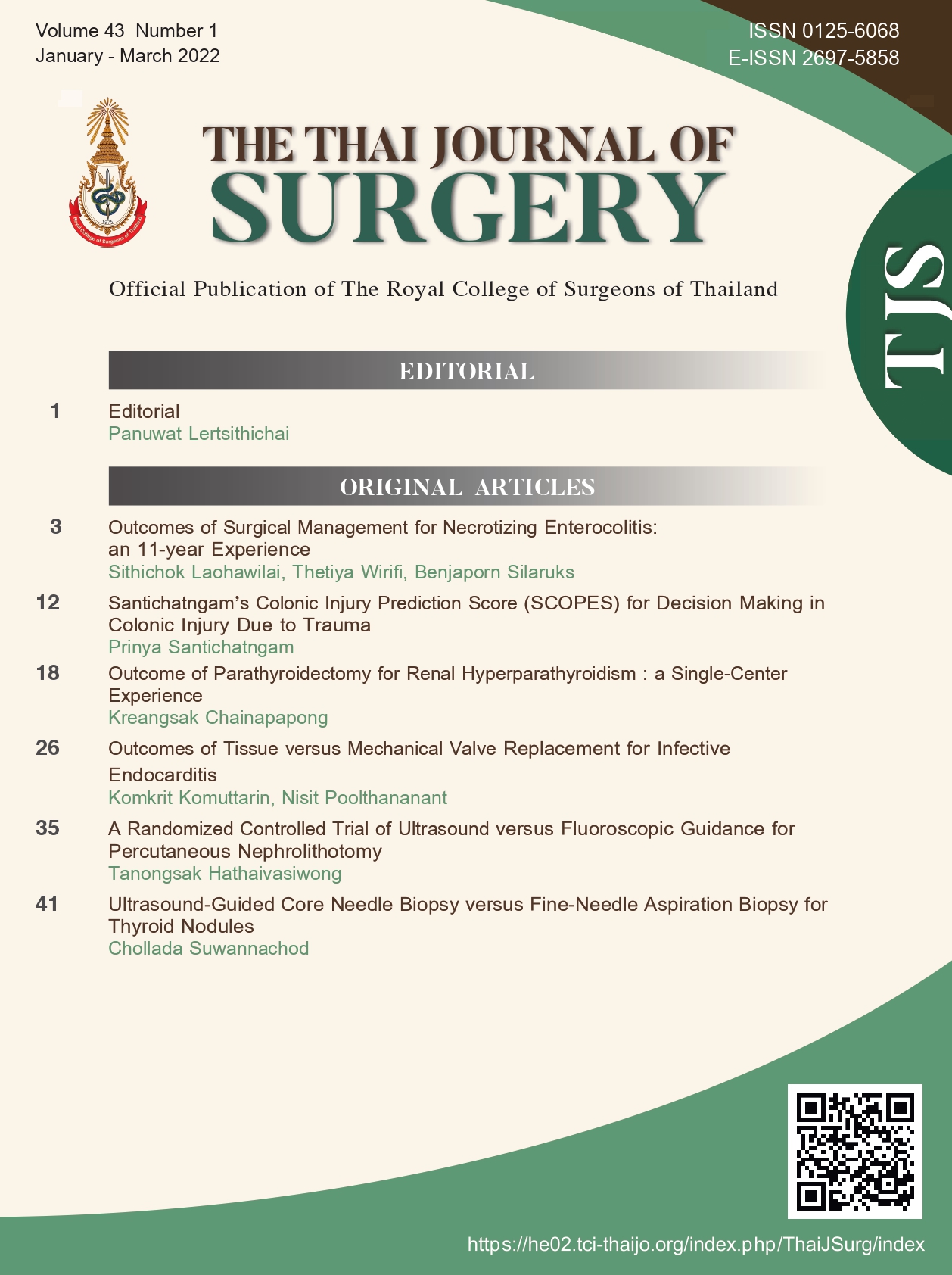Santichatngam’s Colonic Injury Prediction Score (SCOPES) for Decision Making in Colonic Injury Due to Trauma
Keywords:
Clinical prediction score, Colonic injuryAbstract
Objective: Santichatngam's Colonic Injury PrEdiction Score (SCOPES), which was developed in 2017, can assist in surgical decision making for colonic injury, i.e., whether primary repair can be performed or diversion is needed. The aim of the present study was to demonstrate the validity and utility of SCOPES for appropriate surgical decision making in at least grade 3 colonic injury.
Patients and Methods: Medical records of patients with colonic injury who were treated at Maharat Nakhon Ratchasima Hospital from October 1st, 2013 to September 30th, 2019, were reviewed. Two versions of SCOPES were created. Both versions consisted of four factors. In SCOPES version I, if only 1 factor were present, then primary repair is recommended. In SCOPES version II, in the presence of at least 2 major factors, or 1 major factor plus at least 1 minor factor, then a diversion procedure is recommended. The SCOPES recommendation was compared to a reference standard, which was determined by successful operative management and peer review.
Result: The SCOPES version I has a sensitivity of 81%, specificity of 86%, positive likelihood ratio of 5.7, positive predictive value of 96%, and accuracy of 82% for primary repair. The SCOPES version II has a sensitivity of 43%, specificity of 100%, positive likelihood ratio over 10, positive predictive value of 100%, and accuracy of 90% for colonic diversion. Application of SCOPES was useful in decision making in 74% of patients.
Conclusions: The present study demonstrated that SCOPES has good validity and utility in terms of recommending appropriate management. The use of SCOPES in clinical practice may have some advantages over clinical judgment alone.
References
Stone HH, Fabian TC. Management of perforating colon trauma: randomization between primary closure and exteriorization. Ann Surg 1979;190:430–6.
George SM, Fabian TC, Voeller GR, et al. Primary repair of colon wounds. A prospective trial in nonselected patients. Ann Surg 1989;209:728–34.
Ross SE, Cobean RA, Hoyt DB, et al. Blunt colonic injury--a multicenter review. J Trauma 1992;33:379–84.
Murray JA, Demetriades D, Colson M, et al. Colonic resection in trauma: colostomy versus anastomosis. J Trauma 1999;46:250–4.
Demetriades D, Murray JA, Chan L, et al. Penetrating colon injuries requiring resection: diversion or primary anastomosis? An AAST prospective multicenter study. J Trauma 2001;50:765–75.
Ivatury RR, Gaudino J, Nallathambi MN, et al. Definitive treatment of colon injuries: a prospective study. Am Surg 1993;59:43–9.
Gonzalez RP, Falimirski ME, Holevar MR. Further evaluation of colostomy in penetrating colon injury. Am Surg 2000;66:342–6.
Moore EE, Cogbill TH, Malangoni MA, et al. Organ injury scaling, II: pancreas, duodenum, small bowel, colon, and rectum. J Trauma 1990;30:1427–9.
Pezim ME, Vestrup JA. Canadian attitudes toward use of primary repair in management of colon trauma. A survey of 317 members of the Canadian association of general surgeons. Dis Colon Rectum 1996;39:40–4.
Eshraghi N, Mullins RJ, Mayberry JC, et al. Surveyed opinion of American trauma surgeons in management of colon injuries. J Trauma 1998;44:93–7.
Santichatngam P. Santichatngam’s Colonic Injury Prediction Score (SCOPES). Thai J Surg 2017;38:53-8.
Wattakawanick B, Santichatngam P. Reliability of Santichatngam’s colonic Injury prediction score (SCOPES) at Maharat Nakhon Ratchasima Hospital (MNRH). Paper session presented at CMU surgery 60 years and moving forward (the 34th regional meeting of the Royal College of Surgeons of Thailand), Shangri-la Hotel, Chiang Mai, Thailand [unpublished].
Nelson R, Singer M. Primary repair for penetrating colon injury. Cochrane Database Syst Rev. 2003 [cited 2003 Jul 21]. https://www.cochranelibrary.com/cdsr/doi/10.1002/14651858.CD002247.
Cullinane DC, Jawa RS, Como JJ, et al. Management of penetrating intraperitoneal colon injuries: A meta-analysis and practice management guideline from the Eastern association for the surgery of trauma. J Trauma Acute Care Surg 2018;86:505-15.
Moore EE, Cogbill TH, Malangoni MA, et al. Organ injury scaling, III: chest wall, abdominal, vascular, ureter, bladder, and urethal. J Trauma. 1992;33:337-9.
Ross SE, Cobean RA, Hoyt DB, et al. Blunt colonic injury-a multicenter review. J Trauma 1992;33:379-84.
Hunt TK, Hawley RK, Dumphy JE. Aetiology of anatomic leakage. Proc Soc Med (sup I) 1970;63:28-30.
Huber PJ, Thal ER. Management of colon injuries. Surg Clin North Am 1990;70:561-73.
Rose SE, Cobean RA, Hoyt DB, et al. Blunt colonic injury: a multicenter review. J Trauma 1992;33:379-84.
Neikin N, Lewis F. The influence of injury severity on complication rate after primary closure or colostomy of penetrating colon trauma. Ann Surg 1994;168:316-9.
Choi WJ. Management of colorectal trauma. J Korean Soc Coloproctol 2011;27:166–172.
Cheong JY, Keshava. Manangement of colorectal trauma: a review. ANZ J Surg 2017;87:547-53.
Downloads
Published
How to Cite
Issue
Section
License
Copyright (c) 2022 The Royal College of Surgeons of Thailand

This work is licensed under a Creative Commons Attribution-NonCommercial-NoDerivatives 4.0 International License.
Articles must be contributed solely to The Thai Journal of Surgery and when published become the property of the Royal College of Surgeons of Thailand. The Royal College of Surgeons of Thailand reserves copyright on all published materials and such materials may not be reproduced in any form without the written permission.



